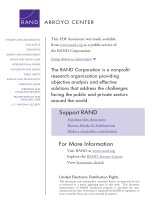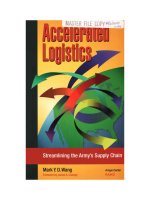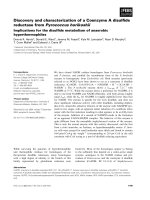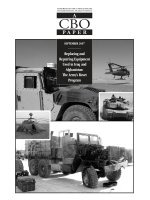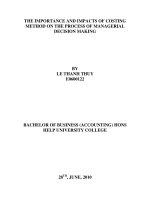The Value and Impacts of Alternative Fuel Distribution Concepts- Assessing the Army’s Future Needs for Temporary Fuel Pipelines pptx
Bạn đang xem bản rút gọn của tài liệu. Xem và tải ngay bản đầy đủ của tài liệu tại đây (1.48 MB, 64 trang )
This document and trademark(s) contained herein are protected by law as indicated in a notice appearing later in
this work. This electronic representation of RAND intellectual property is provided for non-commercial use only.
Unauthorized posting of RAND PDFs to a non-RAND Web site is prohibited. RAND PDFs are protected under
copyright law. Permission is required from RAND to reproduce, or reuse in another form, any of our research
documents for commercial use. For information on reprint and linking permissions, please see RAND Permissions.
Limited Electronic Distribution Rights
This PDF document was made available from www.rand.org as a public
service of the RAND Corporation.
6
Jump down to document
THE ARTS
CHILD POLICY
CIVIL JUSTICE
EDUCATION
ENERGY AND ENVIRONMENT
HEALTH AND HEALTH CARE
INTERNATIONAL AFFAIRS
NATIONAL SECURITY
POPULATION AND AGING
PUBLIC SAFETY
SCIENCE AND TECHNOLOGY
SUBSTANCE ABUSE
TERRORISM AND
HOMELAND SECURITY
TRANSPORTATION AND
INFRASTRUCTURE
WORKFORCE AND WORKPLACE
The RAND Corporation is a nonprofit research
organization providing objective analysis and effective
solutions that address the challenges facing the public
and private sectors around the world.
Visit RAND at www.rand.org
Explore RAND Arroyo Center
View document details
For More Information
Purchase this document
Browse Books & Publications
Make a charitable contribution
Support RAND
This product is part of the RAND Corporation technical report series. Reports may
include research findings on a specific topic that is limited in scope; present discus-
sions of the methodology employed in research; provide literature reviews, survey
instruments, modeling exercises, guidelines for practitioners and research profes-
sionals, and supporting documentation; or deliver preliminary findings. All RAND
reports undergo rigorous peer review to ensure that they meet high standards for re-
search quality and objectivity.
ARROYO CENTER
Prepared for the United States Army
Approved for public release; distribution unlimited
TECHNICAL REPORT
The Value and Impacts of Alternative
Fuel Distribution Concepts
Assessing the Army’s Future Needs
for Temporary Fuel Pipelines
David M. Oaks
t
Matthew Stafford
t
Bradley Wilson
The RAND Corporation is a nonprofit research organization providing objective analysis
and effective solutions that address the challenges facing the public and private sectors
around the world. RAND’s publications do not necessarily reflect the opinions of its
research clients and sponsors.
R
®
is a registered trademark.
© Copyright 2009 RAND Corporation
Permission is given to duplicate this document for personal use only, as long as it is unaltered
and complete. Copies may not be duplicated for commercial purposes. Unauthorized
posting of RAND documents to a non-RAND Web site is prohibited. RAND
documents are protected under copyright law. For information on reprint and linking
permissions, please visit the RAND permissions page (
permissions.html).
Published 2009 by the RAND Corporation
1776 Main Street, P.O. Box 2138, Santa Monica, CA 90407-2138
1200 South Hayes Street, Arlington, VA 22202-5050
4570 Fifth Avenue, Suite 600, Pittsburgh, PA 15213-2665
RAND URL:
To order RAND documents or to obtain additional information, contact
Distribution Services: Telephone: (310) 451-7002;
Fax: (310) 451-6915; Email:
Cover photo courtesy of the 240th Quartermaster Battalion, U.S. Army.
The research described in this report was sponsored by the United States Army under
Contract No. W74V8H-06-C-0002.
Library of Congress Cataloging-in-Publication Data is available for this publication.
ISBN 978-0-8330-4666-6
iii
Preface
After the end of the Vietnam War, the Army developed an improved capability to emplace
above-ground, temporary petroleum pipelines for providing wholesale fuel support to all U.S.
land-based forces, including Air Force, Marine Corps, and Navy forces ashore. Yet this petro-
leum pipeline capability was put into operation in only one of the two major combat opera-
tions in the past 30 years. ere is some question as to whether this single employment was
feasible only because of a unique set of circumstances unlikely to be present in future situations
in light of the expected expeditionary nature of anticipated contingencies. e examination of
this question was the focus of the project entitled “e Value and Impacts of Alternative Fuel
Distribution Concepts.”
e purpose of this report is to document project findings that inform the U.S. Army on
the anticipated future requirements for a petroleum pipeline capability, provide an assessment
of a range of options for meeting those requirements, and offer recommendations contingent
on the decision maker’s appraisal of future conditions. ese findings should be of interest to
those engaged with future Army logistics support force structure requirements.
is research was sponsored by Lieutenant General John M. Curran, the Deputy Com-
manding General, Futures/Director, Army Capabilities Integration Center of the United States
Army Training and Doctrine Command, with oversight provided by Major General Mitchell
H. Stevenson, Commanding General, United States Army Combined Arms Support Com-
mand. It was conducted within RAND Arroyo Center’s Military Logistics Program. RAND
Arroyo Center, part of the RAND Corporation, is the Army’s federally funded research and
development center for policy studies and analyses.
e Project Unique Identification Code (PUIC) for the project that produced this docu-
ment is ATFCR07226.
iv The Value and Impacts of Alternative Fuel Distribution Concepts
For more information on RAND Arroyo Center, contact the Director of Operations
(telephone 310-393-0411, extension 6419; FAX 310-451-6952; email Marcy_Agmon@rand.
org), or visit Arroyo’s web site at />v
Contents
Preface iii
Figures
vii
Tables
ix
Summary
xi
Acknowledgments
xvii
List of Acronyms and Abbreviations
xix
CHAPTER ONE
Introduction 1
Background
1
Motivation for the Study
2
How is Report Is Organized
3
CHAPTER TWO
Pipeline History and Anticipated Requirements 5
Vietnam
5
Operation Desert Shield/Desert Storm
7
Operation Restore Hope: Somalia
7
Operation Iraqi Freedom
8
Marine Corps Hose Reel System in OIF
8
Army Inland Petroleum Distribution System in OIF
10
Providing Drinking Water to the City of Blackstone, Virginia
12
Summary of Observations from History
12
Potential Future Pipeline Requirements
14
CHAPTER THREE
How Well Do Existing and Future Systems Meet Emerging Needs? 17
Inland Petroleum Distribution System (IPDS)
17
USMC HRS
18
Rapidly Installed Fuel Transfer System (RIFTS)
19
Assault Hoseline
20
Tactical Water Distribution System (TWDS)
20
Categories of Future Requirements
20
Evaluation of Candidate Systems
22
vi The Value and Impacts of Alternative Fuel Distribution Concepts
CHAPTER FOUR
Policy Recommendations 25
No Obvious Best Solution
25
No Apparent Rotational Requirement
25
Assess Simultaneous Pipeline Requirement
26
Potential Role for TWDS and Assault Hoseline Units
26
Near-Term Steps
27
Improved Pump Stations
27
Modify PPTO Company
28
Concluding Observations
30
APPENDIX
Data Tables 31
Bibliography
41
vii
Figures
S.1. Sizing Total Pipeline Requirement by Simultaneity xv
2.1. Petroleum Pipelines in Vietnam
6
2.2. HRS Laid in V-Shaped Ditch in Southern Iraq
9
2.3. Trace of USMC Hose Reel System in Iraq
10
2.4. Trace of IPDS and Commercial Pipelines in Kuwait and Iraq
11
2.5. IPDS Used to Supply City of Blackstone, Virginia
13
3.1. U.S. Marine Corps Hose Reel Conduit Being Emplaced in Iraq
18
3.2. RIFTS Prototype
19
3.3. Four Scenarios for Analysis
22
3.4. Initial Screening for Feasibility
23
3.5. Evaluation of Fuel Systems
24
4.1. Sizing Total Pipeline Requirement by Simultaneity
27
A.1. ISB Scenario: No Trucks, Zero Days RSOI for Pipelines (Already Prepositioned)
33
A.2. MCO Fast Scenario: No Trucks, Zero Days RSOI for Pipelines
(Already Prepositioned)
35
A.3. NEO/HA Scenario: No Trucks, Zero Days RSOI for Pipelines
(Already Prepositioned)
37
A.4. MCO Slow Scenario: Nine Days RSOI for Trucks, Zero Days RSOI for Pipelines
39
A.5. Summary Table of Comparative Performance
39
ix
Tables
S.1. Summary of Historical Cases from Vietnam to OIF xii
S.2. Future Scenarios
xiii
S.3. Choice in Light of Most Pressing Concern
xiv
2.1. Summary of Historical Cases from Vietnam to OIF
14
2.2. Summary of Anticipated Future Requirements
15
3.1. Comparison of Pipeline Systems Characteristics
21
4.1. Choice in Light of Most Pressing Concern
25
4.2. Making a Modular PPTO Company
28
4.3. Making a Self-Protecting Modular PPTO Company
29
A.1. Intermediate Staging Base Scenario
32
A.2. MCO Fast Scenario
34
A.3. NEO/HA Scenario
36
A.4. MCO Slow Scenario
38
xi
Summary
e Army maintains the capability to employ temporary petroleum pipelines. With the fiscal
year (FY) 08–13 program objective memorandum (POM) force, the Army proposes to retain
two Active and twelve Reserve Petroleum Pipeline and Terminal Operating (PPTO) com-
panies. ere is the potential to convert up to four of the PPTO companies to a unit design
centered on the in-development Rapidly Installed Fuel Transfer System (RIFTS) technology,
with the remaining companies retaining the existing Inland Petroleum Distribution System
(IPDS) system.
But this temporary pipeline capability has been put into operation in just one of the two
major combat operations of the past 30 years. Moreover, as the Army transforms, the ques-
tion arises whether this single pipeline deployment was feasible only because of a unique set
of circumstances unlikely to recur in anticipated future expeditionary and nonlinear warfare.
If so, there is a further question of whether the Army should reallocate the resources associ-
ated with the pipeline force structure to fill other force structure needs. is report attempts
to answer these questions, starting with a review of historical and anticipated requirements for
temporary pipelines and then moving on to an assessment of existing and future unit designs
to meet future requirements.
e review of historical pipeline use since Vietnam is summarized in Table S.1. Looking
at these instances together as a group, an interesting pattern emerged. Pipelines tended to be
used at discrete groups of distances:
Short cases of 25 miles or less;t
Middle distances of about 50 miles; andt
Long distances of over 100 miles.t
Further, the short-distance uses were the majority, with a few middle-distance occurrences,
and just a single long-distance employment.
1
A review of future pipeline requirements incorporated into war plans and security plan-
ning scenarios revealed a pattern very similar to the historical one. As shown in Table S.2, there
are several short-distance requirements from less than 3 up to 25 miles, some mid-distance
requirements around 50 miles, and again a single long-distance requirement of 160 miles.
ere are several fluid transfer systems with the potential to meet the anticipated future
requirements. As already mentioned, the existing (legacy) system is the IPDS. It is primarily
comprised of 19-foot-long aluminum pipe sections that are 6 inches in diameter. It is high pres-
sure, 740 pounds per square inch (psi), and capable of delivering up to 1 million gallons per
1
e other long-distance case in this list was only partially complete at the end of hostilities and therefore not counted.
xii The Value and Impacts of Alternative Fuel Distribution Concepts
Table S.1
Summary of Historical Cases from Vietnam to OIF
NOTES: HRS = Hose Reel System, AB = air base, AFB = Air Force Base, LWST= lightweight steel tubing,
IPDS = Inland Petroleum Distribution System.
Short Distance Up to 25 Miles
Somalia MOGADISHU: PORT–AIRFIELD
t 2.5 miles: 6˝ IPDS
Medium Distance ~50 Miles
Vietnam DONG NAI–LONG BIN AB
t 4 miles: 6˝ LWST (3 parallel)
POL PIER–CAM RANH BAY AFB
t 6 miles: 6˝ LWST (2 parallel)
SAIGON–TAN SAN NHUT AFB
t 6 miles: 6˝ LWST (2 parallel)
PHAN RANG–PHAN RANG AFB
t 10 miles: 6˝ LWST (2 parallel)
QUI NHON–PHU CAT AFB
t 17 miles: 6˝ LWST
VUNG RO BAY–TUY HOA
t 18 miles: 6˝ LWST (2 parallel)
QUI NHON–AN KHE
t 50 miles: 6˝ LWST
AN KHE–PLEIKU
t 59 miles: 6˝ LWST
Long Distance 100 Miles +
Total 7 (8) 3 1 (2)
Desert
Shield
RAS TANURA–KING FAHD APT
t 25 miles: 6˝ IPDS
(contaminated, not used)
ADDAMMAM-HAFIR AL BATIN
t 260 miles: 6˝ IPDS (partially
complete at time of cease
fire)
Iraqi
Freedom
USMC: BP WEST–LSA VIPER
t 54 miles: 6˝ HRS
UDARI–TALLIL
t 160 miles: 6˝ IPDS
day. A PPTO company is the Army unit designed to operate up to 90 miles of IPDS pipeline.
2
Emplacement of 90 miles of pipeline would take about a month using the planning factor of 2
to 3 miles per day. e IPDS system also contains organic storage capacity up to 3.78 million
gallons in fabric bags.
e developmental replacement for IPDS is the RIFTS. Two key differences from IPDS
are that (1) the RIFTS uses a flexible 6-inch hoseline that is expected to be as capable as IPDS
in terms of throughput; and (2) the emplacement rate is projected at 20 miles per day. In test-
ing to date, the RIFTS hose has not yet achieved high-enough pressure to make it as capable
as IPDS, and its unit design does away with the organic storage capability.
Similar to the RIFTS concept is the Marine Corps’ Hose Reel System (HRS). It, too, is
based on a flexible 6-inch hoseline that can be rapidly emplaced. HRS operates at low pressure
but is a proven system already used in combat. It has the organic capability to store over 1.1 mil-
lion gallons. A fourth delivery capability, a 7,500-gallon tanker truck company, was included
in the comparative analysis, as this is an alternative to employing temporary pipelines.
2
An Engineer Pipeline-Construction Support Company is the unit doctrinally tasked to emplace temporary pipelines, as
described in Headquarters, Department of the Army, Field Manual 5-482, Military Petroleum Pipeline Systems, Washing-
ton, D.C.: Department of the Army, August 26, 1994, p. 1-8.
Summary xiii
Table S.2
Future Scenarios
EventRequirement Time Sensitive?
Length
(miles) Unclassified Description
A ISB Yes25
(likely requiring
multiple lines)
Permissive but remote location, time sensitive,
very high throughput required
B MCO Yes50 Time-sensitive requirement to move POL
C MCO Yes50 Time-sensitive requirement to move POL
D NEO Yes10 Austere environment, potential requirement
to support other nations’ forces as well
E HA/HLD Yes10 Austere environment, respond to an
environmental disaster
F MCO No160 Long distance pipeline, not time sensitive
G MCO No35
(likely requiring
multiple lines)
Not time sensitive, very high throughput
H MCO No10 Short distance, not time sensitive
ese four systems, IPDS, RIFTS, HRS, and tanker trucks, were assessed in their perfor-
mance against four key future scenario types: intermediate staging base (ISB), noncombatant
evacuation operation (NEO), time-sensitive major combat operation (MCO), and non-time-
sensitive MCO. e evaluation metrics are strategic deployability, number of soldiers required,
time to emplace,
3
and potential investment cost. is analysis yields no clear winner among
the four systems. IPDS does well in cost and soldiers required but is slow to emplace. Trucks
are deemed an infeasible solution for two of the scenarios and are much less efficient as the fuel
delivery distance increases. RIFTS is the fastest to emplace but the most expensive and with
technical performance development hurdles still to be overcome. Finally, the HRS is economi-
cal and fast to emplace but becomes, like trucks, more inefficient as delivery distance increases
in that an increasing number of pump stations and associated personnel are required.
erefore, the overall recommendation is to proceed within the context of the decision
maker’s most important concern, as shown in Table S.3. If cost, for example, is the most press-
ing issue, then the best choice is to retain the IPDS system, perhaps supplemented by some
limited acquisition of HRS hoseline. Alternatively, if strategic mobility of pipeline assets is the
most important issue, then acquisition of RIFTS or the selective prepositioning of IPDS assets
are the best options.
Temporary pipelines remain an attractive capability to retain in the force structure, but
the question is how much. Unlike many support requirements, though, temporary pipelines
do not appear to have a rotational requirement. It is generally not cost-effective to employ a
pipeline unit if the fuel requirement is small or infrequently required. And as they pose an
3
e use of “time to emplace” as a key measure may be seen as less compelling than other measures, such as “gallons deliv-
ered per unit time.” In the context of this research, though, the alternative newer system the Army was seriously consider-
ing, RIFTS, was promoted primarily due to its promised speed of emplacement while holding delivery volume essentially
constant. is was to be the overriding “selling point” and most-often-cited parameter in various war plans (which often do
not make reference to a required number of gallons of fuel to be delivered over time).
xiv The Value and Impacts of Alternative Fuel Distribution Concepts
Table S.3
Choice in Light of Most Pressing Concern
If highest concern is . . . . . . then choose
Cost IPDS (maybe HRS)
Mobility RIFTS (or prepo IPDS)
Time to employ RIFTS
Personnel IPDS + RIFTS
Technical risk IPDS + trucks
obstacle to maneuver of both military and indigenous traffic and, in contested areas, present
an inviting target for enemy mischief or theft and pilferage, it is not desirable to keep them in
place too long. And by their temporary nature in design and materials, they degrade over time,
leaking or failing.
So one approach to take to estimate the total amount of temporary pipeline equipment
and units needed is to assess how much might be needed simultaneously based upon which
future scenarios might occur simultaneously. Figure S.1 indicates that about 500 miles of
pipeline capability could cover all requirements at the same time, providing one estimate.
Naturally, a rational case can be made for lesser totals or for dividing totals by capability. For
example, if the Army decides to continue acquisition of a hoseline-based system, a reasonable
amount could be 220 miles, an amount to cover the more time-sensitive scenarios, leaving
the legacy IPDS systems to cover the remaining 275 miles of less time-sensitive contingency
requirements.
The Way Ahead for the Army
Temporary pipeline capabilities do not come without costs. Pipelines take time and resources
beyond the petroleum pipeline units, notably engineer support, to set up and operate. Allocat-
ing acquisition dollars to new technology, primarily flexible hoseline, and improved pumping
stations can lessen emplacement time and the engineering support required. e Army should
consider focused investments in these areas. Similarly, the need to protect the pipeline against
pilferage or sabotage also remains, a task the Military Police are doctrinally expected to per-
form but one typically beyond their ability to cover due to other demands in theater.
4
Reor-
ganization of the personnel allotted to the existing PPTO Company can make that unit more
capable of self-protection, again, a step the Army should consider taking, as is the possibility
of merging PPTO, Assault Hoseline, and Tactical Water Distribution System teams into one
fluid-transfer-capable unit type (that is, a multi-function unit capable of operating either POL
or water equipment but not defined by its equipment type).
4
While the numbers of Military Police (MP) units that could potentially be needed to support pipeline operations may
be of interest, this study does not address this question for the following reasons. Of the scenarios surveyed, several are in
permissive environments, which indicates that MP support is not always necessary. Further, the rules of allocation for MP
units in the current Total Army Analysis process include no direct link between units, such as the Military Police Combat
Support Company, and a requirement to protect a distance of pipeline.
Summary xv
Figure S.1
Sizing Total Pipeline Requirement by Simultaneity
Length
(miles) Event
Requirement
A ISB75
(3 × 25)
B MCO50
C MCO50
D NEO10
E HA/HLD10
F MCO160
G MCO105
(3 × 35)
H MCO10
RAND TR652-S.1
195 miles
(more time
sensitive)
275 miles
(less time
sensitive)
470 miles
(if all occurred
simultaneously)
~700 miles of IPDS today
~195 + training set = 220-mile RIFTS buy
xvii
Acknowledgments
e authors would like to thank Colonel Shawn Walsh for sharing his experience as com-
mander of the unit that operated the IPDS pipeline during OIF-1 and for other advice and
insights on pipeline operations. At CASCOM, Tim Trauger, Mari Wells, Major Don Herko,
William Perdue, Charles Burden, and Colonel Dan Mitchell were very helpful in providing
historical data, technical information, and feedback during in-progress reviews. Mike Pend-
ergast from the office of the Army Deputy Chief of Staff, G4, provided very helpful access to
and suggestions on the use of future planning scenarios.
Special thanks go to several at the Radian Corporation and the Marine Corps. At Radian,
Kevin Stump and Ed Martin were very generous in sharing their personal experience and tech-
nical analysis of various pipeline systems, and in making time available both at their offices
and in the field at the FORSCOM pipeline training area at Camp Pickett, Virginia. Joe Irwin
of the Marine Corps Systems Command was likewise very willing to take time to explain the
organization, equipment, and experience of the Marine Hose Reel System used in Iraq. Other
Marines helped tell this story, most notably Mike Giambruno.
At RAND, Jerry Sollinger provided assistance with organizing this document, and Dave
Orletsky, Eric Peltz, and Rick Eden provided thorough reviews. Errors of fact or interpretation
remain the responsibility of the authors.
xix
List of Acronyms and Abbreviations
CASCOM Combined Arms Support Command
COCOM Combatant Command
FORSCOM Forces Command
gpm gallons per minute
HA Humanitarian Assistance
HEMTT Heavy Expanded Mobility Tactical Truck
HRS Hose Reel System
IPDS Inland Petroleum Distribution System
ISB Intermediate Staging Base
ISO International Organization for Standardization
LSA Logistics Support Area
LWST Lightweight Steel Tubing
MAOP Maximum Allowable Operating Pressure
MCO Major Combat Operation
MP Military Police
NEO Noncombatant Evacuation Operation
ODS Operation Desert Storm
OIF Operation Iraqi Freedom
OPDS Offshore Petroleum Distribution System
POL Petroleum, Oil, and Lubricants
PPTO Petroleum Pipeline and Terminal Operating (Company)
RC Reserve Component
RIFTS Rapidly Installed Fluid Transfer System
RSOI Reception, Staging, Onward movement, and Integration
TAA Total Army Analysis
TAFDS Tactical Airfield Fuel Dispensing System
TACOM Tank-automotive and Armaments Command
TO&E Table of Organization and Equipment
TPT Tactical Petroleum Terminal
TWDS Tactical Water Distribution System
1
CHAPTER ONE
Introduction
Background
Pipelines are the most efficient means for moving large volumes of liquid products. In the
United States they move two-thirds of the oil transported annually, roughly thirteen billion
barrels of both crude and refined petroleum products, safely and at a cost much lower than
railroads, trucks, or barges can offer.
1
Because of these positive attributes, today the United
States has the densest network of petroleum pipelines in the world.
Like the commercial sector, the U.S. Army has had a history of investing in the personnel
and materiel that enable it to construct and operate petroleum pipelines. With a general plan-
ning estimate for half of all sustainment tonnage moved in a theater of operations to consist
of petroleum products, military use of pipelines is an attractive proposition.
2
Moreover, Joint
doctrine for bulk petroleum clearly names pipeline distribution as the preferred method for
inland petroleum distribution.
3
e Army’s pipelines differ from those used commercially, however, in that they are
above-ground systems purposely designed for deployment, easy emplacement, operation, and
retrieval. e currently fielded pipeline system dates to the period just after the Vietnam War,
when the Army found itself with only 25 miles of non-mission-capable petroleum distribution
equipment on hand.
4
To resolve this problem, an improved pipeline set with then state-of-the-
art technology was developed in the mid-1970s, together with an associated unit to operate it.
is improved pipeline, called the Inland Petroleum Distribution System (IPDS), can be
much more quickly emplaced than the World War II vintage lightweight steel tubing (LWST)
system it replaced, and can deliver larger amounts of petroleum.
5
Among the many technical
improvements to the IPDS were that each pipe section is aluminum and weighs 110 pounds,
making it man-portable, and assembly was made much easier in that pipe sections are joined
with a simple hammer-driven pin as opposed to the two bolts and nuts required for the LWST
1
Association of Oil Pipelines, Safety Record. As of January 2009, navigable from:
2
Headquarters, Department of the Army, Field Manual 10-67, Petroleum Supply in eaters of Operations, Washington,
D.C., February 18, 1983, p. 2-1.
3
Joint Chiefs of Staff, Joint Publication 4-03, Joint Bulk Petroleum and Water Doctrine, Washington, D.C.: Joint Chiefs
of Staff, May 23, 2003, p. I-4.
4
Kevin Born, “Short History of Tactical U.S. Military Pipelines,” An Assessment of the Rapidly Installed Fluid Transfer
System (RIFTS), Alexandria, VA: Radian, Inc., January 2004, Appendix A.
5
Keith E. Mattox, “e Army’s Inland Petroleum Distribution System,” Quartermaster Professional Bulletin, Spring
1998.
2 The Value and Impacts of Alternative Fuel Distribution Concepts
system. Strategic mobility was improved, as each IPDS pipe is just 19 feet in length, making
it able to fit inside a 20-foot International Organization for Standardization (ISO) container,
and fewer pump stations were needed because the IPDS has a higher maximum allowable
operating pressure (MAOP) of 740 pounds per square inch (psi), as compared to the 600 psi of
the LWST system.
6
Today, the Army has roughly 700 miles of IPDS conduit (in various states
of readiness) and 14 company-sized pipeline operating units (in both the Active and Reserve
components) in its inventory.
Motivation for the Study
Since its creation roughly 30 years ago, the IPDS pipeline system has been used at its full design
potential only once, during Operation Iraqi Freedom. ere is a concern that this singular use
might have been an artifact of the particularly favorable set of conditions. e nature of the
specific theater, which has relatively open and flat terrain and nearby large petroleum refining
facilities, facilitated the use of IPDS. Additionally, certain aspects of the operation—including
a friendly host nation, long preparation time, and the ability to safely preposition assets and
personnel—were ideal for the use of IPDS. ese conditions are different from the expecta-
tions driving a significant amount of Department of Defense planning, with expectations of
the need to handle nonlinear battlefields, expeditionary operations, and irregular forces.
Over the past few years, force developers at the Combined Arms Support Command
(CASCOM) and materiel developers at the Tank-Automotive and Armaments Command
(TACOM) have created a new unit design and associated prototype equipment for a pipeline
system that promises improvement over the IPDS. e key difference is the replacement of
the IPDS’s rigid pipe sections with a flexible hoseline carried in a vehicle-mounted motorized
drum. It is hoped that this system, known as the Rapidly Installed Fluid Transfer System
(RIFTS), will reduce long-distance pipeline emplacement times from days to hours, and like-
wise will be able to be much more quickly retrieved and emplaced again elsewhere on the
battlefield. It is this attribute of speed of emplacement that designers see as the key response to
keep petroleum pipelines viable in a future expeditionary, nonlinear combat environment. e
big drawbacks of the RIFTS are that its prototypes have not yet met anticipated performance
in terms of MAOP within the hoseline and its high cost, due to both the advanced technology
of the conduit itself and the dozens of large vehicles (Heavy Expanded Mobility Tactical Truck
[HEMTT]-sized) in the unit design. ese concerns and higher priority funding needs in the
Army budget have slowed materiel development of the RIFTS system and slowed support for
migration to the RIFTS unit design.
e obvious alternative to temporary pipelines is truck units, either ones organic to the
Army, furnished by coalition partners, or those contracted for with commercial providers. e
Army is already taking some risk with its pool of organic truck units in that it has fewer units
than its planning process indicates it may require to meet future wartime demands.
7
Counting
6
Born, Appendix A.
7
For example, the Total Army Analysis (TAA) 08–13 results indicated a requirement for 55 Medium Truck Companies,
Cargo (echelon above corps or EAC), but only 50 were resourced in the POM 08–13 Army Structure Message in April
2006.
Introduction 3
on support from partners or civilian providers is not a preferred alternative early in a conflict,
because quick access to such assets cannot be assured.
us, the Army faces tough choices on how to distribute its allotted share of manpower
and materiel investment resources to units. Should it continue with its current set of IPDS
equipment and units and perhaps miss an opportunity to reinvest some or all of the resources
they represent against truck unit shortages? Alternatively, should the Army take today’s pipe-
line resources and reinvest part or all in the new but unproven RIFTS design? Or are there
other alternatives?
How This Report Is Organized
e report is laid out as follows. Chapter Two reviews the historical use of pipelines from the
Vietnam War up through and including Operation Iraqi Freedom, and examines potential
future fuel pipeline requirements based upon modeling scenarios, existing combatant com-
mand (COCOM) operation plans, and illustrative planning scenarios. From this review of
history and anticipated needs, a picture of expected future demands for pipelines emerges.
Chapter ree provides an assessment of existing and future units and technologies to meet
these demands, including an estimate of some relative costs to pursue each of these technolo-
gies/unit types. Finally, the report concludes with findings and policy recommendations.

